What does it take to be a good leader? How do business leaders inspire those around them? And what leadership styles can you adopt for your own needs?
If you’re a manager, mentor, or business executive looking for answers to those questions, you’ve come to the right place. I’m an author, university professor, and management consultant who speaks around the globe about effective leadership. I’ve spent decades studying leadership and teaching others how to use leadership techniques to accomplish their goals.
But before we dive into the 5 most common leadership styles and how you can develop a style of your own, let’s kick off with a definition of leadership. After all, we can’t dig into leadership styles before we define what it means to be a leader.
There are thousands of definitions of leadership, many of which are convoluted and hard to understand. When it comes to definitions, the best ones are simple, clear, and surprisingly profound.
So, with that in mind, I’d like to point you to David Rubenstein’s definition which can be found in his excellent book, How to Lead.
“A leader is someone who makes something happen that wouldn’t have happened otherwise.”
Eisenhower was a great leader. Steve Jobs was a great leader. Sheryl Sandberg is a great leader. As are Oprah Winfrey, Jeff Bezos, Indra Nooyi, and Elon Musk.
Why? Because they’re all people who made something happen that wouldn’t have happened otherwise.
A roadmap for effective leadership
Which kind of leader do you want to be? Hopefully, you want to be a leader who is both effective and well-liked by the people you’re leading. (Studies show that leaders who are well-liked and admired are more effective than those who are not well-liked or admired.)
With that in mind, let’s take a look at the Four Pillars of Leadership, which is a 2×2 framework I’ve developed based on decades of experience and which I share in workshops and consulting assignments around the globe.
The purpose of the Four Pillars is to help you wrap your mind around the techniques you’ll be using to become a better leader.
On the X-axis, you’ll see techniques that are deployed either one-to-one (on the left) or one-to-many (on the right). In other words, these techniques are executed from you to one person or from you to many people.

On the Y-axis, you’ll see techniques that are defined as Inward (What You Tell Yourself) and Outward (What You Tell Others).
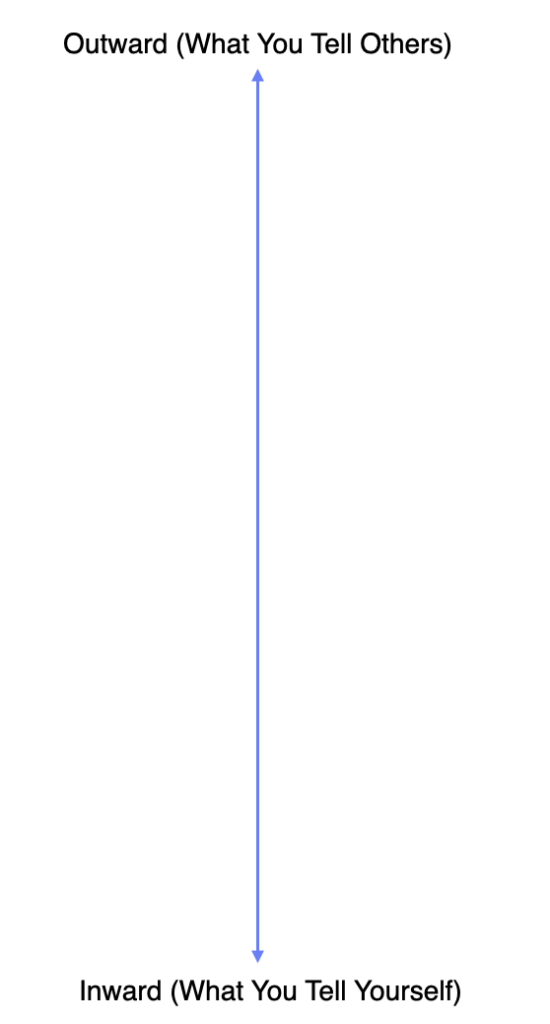
If that’s a little confusing, don’t worry because it’ll make more sense in a second.
When you put the two axes together, it looks like the 2×2 framework below, with four separate quadrants.
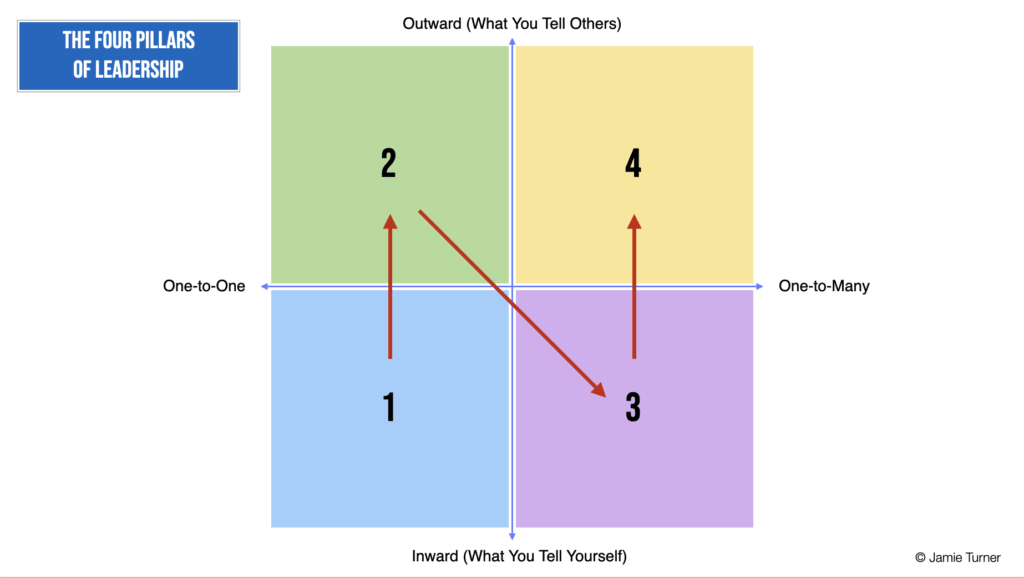
Quadrant one is made up of techniques you tell yourself in a one-to-one capacity. These techniques are based on the idea that all great leaders work on their mindset first and their skillset second. So, quadrant one is about mindset.
Quadrant two is made up of techniques you tell others in a one-to-one capacity. These techniques are ones that you’ll use when you’re mentoring an employee. So, quadrant two is about mentoring.
Quadrant three is made up of techniques you tell yourself in a one-to-many scenario. Let’s say you’re managing a small team — these are the kinds of things you would tell yourself so that you could be a better manager, mentor, or team leader. So, quadrant three is about management.
Quadrant four is made up of techniques you tell others in a one-to-many scenario. These are techniques you would use when communicating to large groups of employees or to large groups of customers. So, quadrant four is about marketing.
Here’s what the Four Pillars of Leadership looks like when you add mindset, mentoring, management, and marketing to the framework.
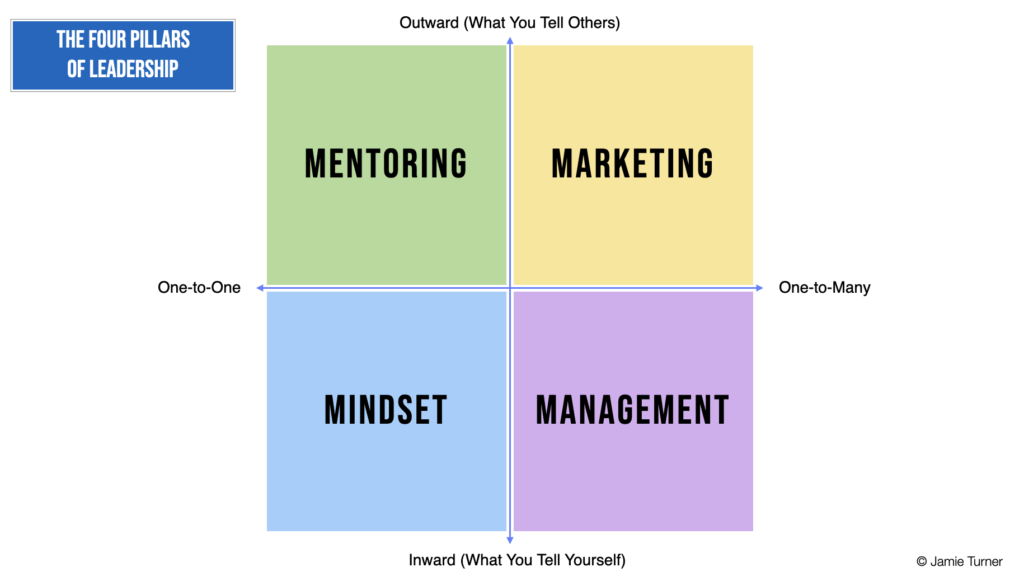
Before we move forward and talk about the 5 styles of leadership, let’s unpack some of the techniques you can use based on the Four Pillars shown above. By putting these techniques into practice, you’ll develop your own unique style of leadership, which will help you be an authentic, genuine, and more effective leader.
Mindset
All great leaders understand that it takes a certain mindset to be an effective leader. With that in mind, here are some of the techniques from quadrant one that you can use to work on your mindset.
- Choose to act rather than react. Many executives wait for stimuli before taking action. In other words, they wait for something to happen to them and then play defense by reacting to whatever happened. Successful leaders play offense. In other words, they make something happen rather than waiting for something to happen to them.
- Understand that failure is not an ending, it’s a beginning. We learn more from our failures than we do from our successes. So remember, every failure in life teaches you things you can apply later in your life. As Frederich Nietzsche said, “That which does not destroy us makes us stronger.”
- Recognize that confidence is the product of action. Many people believe that confident leaders are either born confident or are told so many wonderful things about themselves that they magically feel confident. The truth is that confidence happens when you’ve taken action on something and seen it come to fruition. So remember, confidence isn’t about saying wonderful things about yourself, it’s about taking action and seeing positive results.
Mentorship
If you’re interested in leadership, the odds are you’ve been asked to lead a team, an organization, or an entire company. With that in mind, one of your most important skillsets will be to mentor those around you. And the secret to mentorship comes down to one thing – empathy.
Let’s take a look at the techniques you can use to become a more effective mentor.
- Recognize that all humans are motivated by self-interest. There’s one thing all humans have in common — we’re usually motivated by what benefits us, not necessarily by what benefits others. (There are some exceptions, of course.) With that in mind, it’s important to understand that any mentoring you do has to be motivated by the recipient’s self-interest. In other words, what’s in it for them? How can you make your goals (or your organization’s goals) match what they want in life?
- When mentoring, start with what, not why. When you start with “Why did you do that?” it sounds accusatory. When you start with “What were your plans when you took that action?” it’s less accusatory. That small change can build a bridge between you and the person you’re mentoring.
- Err on the side of Grace. As a mentor, you’ll have plenty of opportunities to correct the behavior of your mentee. When those times arise, err on the side of Grace rather than the law. In other words, be kind and generous in your feedback, rather than dictatorial and abrasive. Of course, there will be exceptions to this, but in order to build a long-term relationship with your mentee, it’s better to start from a place of Grace rather than the law.
Management
Management is about getting teams of employees to follow your suggestions and your recommendations. With that in mind, let’s take a look at how good communication skills can help you become a better leaders.
- 80% of business problems can be solved through better communication. It’s hard to believe, but the vast majority of problems in business revolve around misunderstandings, vague instructions, and lack of clear dialogue. In my consulting practice and my workshops, we spend a great deal of time working out ways to improve communication.
- People want to be told which mountain to climb, not how to climb it. The quickest way to de-motivate a team is to micro-manage them. Instead, let them know which mountain they should climb and then support them if (and only if) they need help.
- Successful meetings start with successful endings. It’s always surprising to see how many meetings end with no clear call-to-action. Many times, people simply wrap up meetings with no summary or next steps. You can double the effectiveness of your meetings by re-capping the key insights and assigning action items to the attendees.
Marketing
Whether you’re communicating with your staff or with your customers, it all comes down to marketing. In other words, it comes down to packaging your message so that it resonates with your audience on an emotional level.
Let’s take a look at how you can become a better marketer, whether you’re talking to your staff or talking to your customers.
- The best messages are simple and easy-to-understand. In my work with The Coca-Cola Company, Holiday Inn, and other global brands, one of the key things I try to do is to simplify their messaging. Why is this so important? Because for a message to stick, it has to be something that resonates emotionally and that they can remember on a moment’s notice.
- Your audience is inundated with other messages. Your audience is flooded with thousands of pieces of communication each day. As a result, they can get confused and conflicted. So keep things simple and easy-to-understand.
- Follow the rule of threes. For reasons that aren’t entirely clear, the human brain thinks in groups of three. It’s almost as if the brain is pre-programmed that way. So try to break concepts down into groups of three. If you find yourself needing to communicate more than three key points, it’s better to break them down rather than trying to force your audience to remember all 6 or 7 or whatever the number is. In other words, share two groups of three concepts rather than six concepts all at once.
The five most common leadership styles
Okay, we’ve covered a lot of ground here. We started by discussing the Four Pillars of Leadership and then explored several concepts in each of the four pillars. Now it’s time to discuss the five most common leadership styles.
The leadership styles outlined below are based on my research and my experiences. Some of the research is based on studies at Harvard, Stanford, and other institutions. Other sources of information include my own experiences while running a small global consulting firm.
With all that in mind, let’s dive in to the five most common styles of leadership.
The Visionary Leader
Visionary leaders are people who see the world not how it is, but how it could be. Some examples of visionary leaders include Steve Jobs with Apple, Indra Nooyi with PepsiCo, and Jeff Bezos with Amazon. In each of these three cases, they saw the world slightly differently than the rest of us did.
“Some people say give the customers what they want, but that’s not my approach. Our job is to figure out what they’re going to want before they do. People don’t know what they want until you show it to them. That’s why I never rely on market research. Our task is to read things that are not yet on the page.” – Steve Jobs
Steve Jobs saw a world with products that unleashed human potential. Indra Nooyi saw a company that needed to move towards healthier snacks. And Jeff Bezos saw a world that used digital technology to shorten the distance between consumers and the brands they love.
If you have a vision for your company or for the team you’re leading, use the techniques outlined in quadrant four (marketing) of the Four Pillars of Leadership. Keep your messages simple and make sure they’re emotionally appealing to your audiences. When possible, communicate them in groups of three. And if you can tie your organization’s goals to each individual’s goals, your messages will resonate more deeply.
The Builder
Leaders who are builders are people who take something already established and have the drive and smarts to build it into something better than before. Examples include Howard Schultz with Starbucks, Tim Cook with Apple, and Ginni Rometty with IBM.
“If you dream small dreams, you may succeed in building something small. For many people, that is enough. But if you want to achieve widespread impact and lasting value, be bold.” – Howard Schultz
Howard Schultz was not the founder of Starbucks. He was hired as the director of retail operations and marketing for a brand that had a few locations. But he was also a builder and took the foundational components of the brand and built it into what it is today.
In similar fashion, Ginny Rometty became CEO of IBM in 2012 and proceeded to reinvent more than 50% of the organization’s portfolio. She built a $21 billion hybrid cloud business and established IBM’s leadership in AI, quantum computing, and blockchain.
And Tim Cook (who is also listed as a Sequential leader) took what Steve Jobs and Steve Wozniak started and built it into the behemoth it is today.
People who are Builders will want to focus some of their efforts in quadrant three (management) of the Four Pillars of Leadership. If your goal is to take an existing business or division and grow it into something larger and more expansive, then learning how to manage others will be critical to that task.
Remember that 80% of the problems you’ll face are likely to be fixed just through better communication – I know that’s hard to believe, but I’ve seen it play out time and time again. So, keep good communication at the forefront of your management style.
The Empathetic Leader
Empathetic leaders lead from a place of teamwork, culture, and partnering. Their gift is that they make people feel included in the organization’s larger cause and direction. Well-known empathetic leaders include Melinda Gates, Sheryl Sandberg, and Oprah Winfrey.
“The key to realizing a dream is to focus not on success but significance — and then even the small steps and little victories along your path will take on greater meaning.” – Oprah Winfrey
Oprah Winfrey became a billionaire for a number of reasons – she’s incredibly intelligent, her timing is spot-on, and her empathy for her followers shows through in just about everything she does. I have never met Oprah, but just watching her engage with her audiences and her guests is a case study in how to be kind, thoughtful, and empathetic.
Melinda Gates is the co-chair of the Bill and Melinda Gates Foundation which is an organization that, at its core, is based on empathy for impoverished people around the globe. Sheryl Sandberg, who is the COO of Facebook and the author of Lean In, has worked hard to ensure that the operations are running smoothly at Facebook while at the same time being empathetic to those she leads.
The challenge with being an empathetic leader is that there are times you have to make tough decisions around hiring, firing, and promotions. If you’re too empathetic, then making the difficult decision to fire someone can sometimes get in the way of that. So empathetic leaders should focus a lot of their attention on quadrant one (mindset). By centering their attention on their thoughts and the actions that arise from those thoughts, an empathetic leader can overcome some of the challenges of being thoughtful and kind.
The Disruptor
Disruptors are people who see the world as an imperfect place that needs to be fixed. They understand the world as it is, but also have the drive to make it a better place. They’re slightly different from visionary leaders in that they’re more operationally focused. In other words, they don’t just create a big, all-encompassing vision and then set their course for the stars (the way visionary leaders do). Instead, they see a problem, be it large or small, and work relentlessly to fix that problem. Examples of disruptors include Ruth Bader Ginsburg, Elon Musk, and Bill Gates.
“If you’re trying to create a company, it’s like baking a cake. You have to have all the ingredients in the right proportion.” – Elon Musk
Elon Musk is the founder of Tesla, SpaceX and a variety of other game-changing organizations. He has had success because he disrupted the way most of us think of the world around us.
Ruth Bader Ginsburg was an associate justice of the Supreme Court from 1993 until her death in 2020. She was nominated by President Bill Clinton and was generally viewed as a moderate consensus-builder. And, of course, Bill Gates is the co-founder of Microsoft and now helps impoverished people around the globe through the Bill and Melinda Gates Foundation.
One of the driving forces for most leaders who fall into the disruptor category is a passion and a drive for how they see the world. They tend to be less focused on success in any traditional sense and more focused on changing their corner of the world.
If you feel as though you fall into the disruptor category, then you probably feel comfortable bucking the system or going counter to the conventional wisdom. Entrepreneurs, creative types (e.g., musicians, artists, etc.) and solopreneurs often fall into the disruptor category.
The Sequential Leader
Sequential leaders are people who lead from a place of organization, attention-to-detail, and careful planning. Tim Cook with Apple, Marillyn Hewson with Lockheed Martin, and Robert Smith with Vista Equity Partners are all examples of sequential leaders.
“It’s about finding your values and committing to them. It’s about finding your North Star. It’s about making choices. Some are easy. Some are hard. And some will make you question everything.” – Tim Cook
To be honest, when Tim Cook took over for Steve Jobs at Apple, I figured he wouldn’t last more than a year or two. Jobs was a visionary and Cook was a operations guy who was going to be compared to Jobs for the rest of his career. It turns out I was spectacularly wrong about Tim Cook – he helped turn Apple into the first company with a market capitalization of $1 trillion. And then, just to top it off, he added another $1 trillion in market capitalization just 18 months later.
Marillyn Hewson is the chairman, and former president and CEO of Lockheed Martin. Her attention to detail and her operationally-focused mindset has helped her succeed in an industry that’s notoriously male dominated. And Robert Smith is the founder, chairman, and CEO of investment firm Vista Equity Partners and was listed in Forbes as one of the 100 greatest living business minds.
Sequential leaders tend to be operationally-focused. They’re attentive to details, excellent with follow-through, and see the business world as a chess match where the organization wins the game of business by thinking long-term rather than short-term.
Which of these best fits your leadership style?
Are you a visionary? A builder? Are you empathetic? A disruptor? Or are you a sequential leader?
There are no right or wrong answers. But understanding your style as well as the style of those around you can make you a better executive, manager, and leader.
If you’re interested in fine-tuning your own personal style, you might want to visit the Communication Styles Matrix developed by Dr. Eileen Russo. It divides communication styles into four different quadrants.
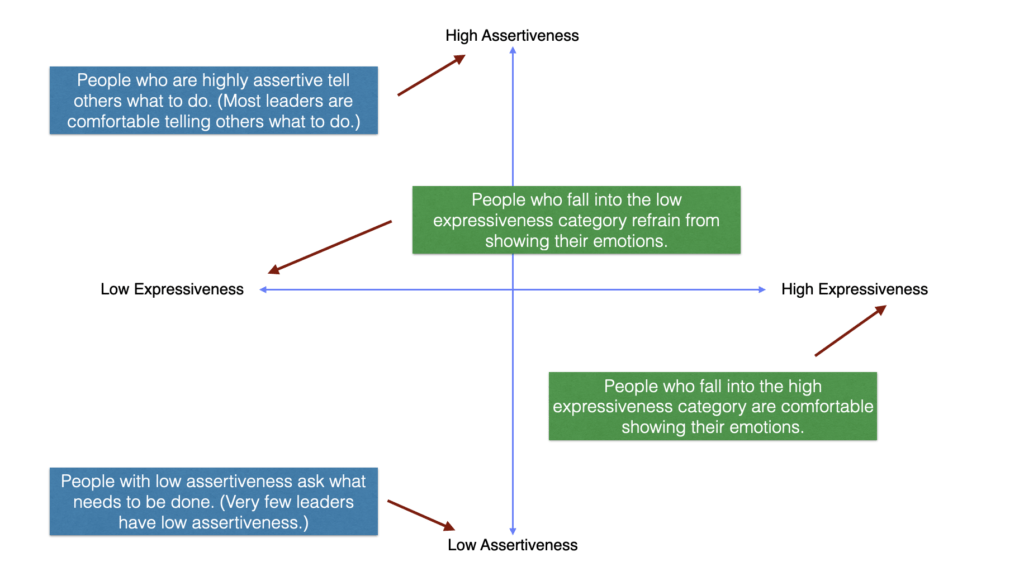
Examine your own communication style by using the quadrants above. In the end, you’ll fall into one of the four quadrants: Direct, Spirited, Systematic, and Considerate.
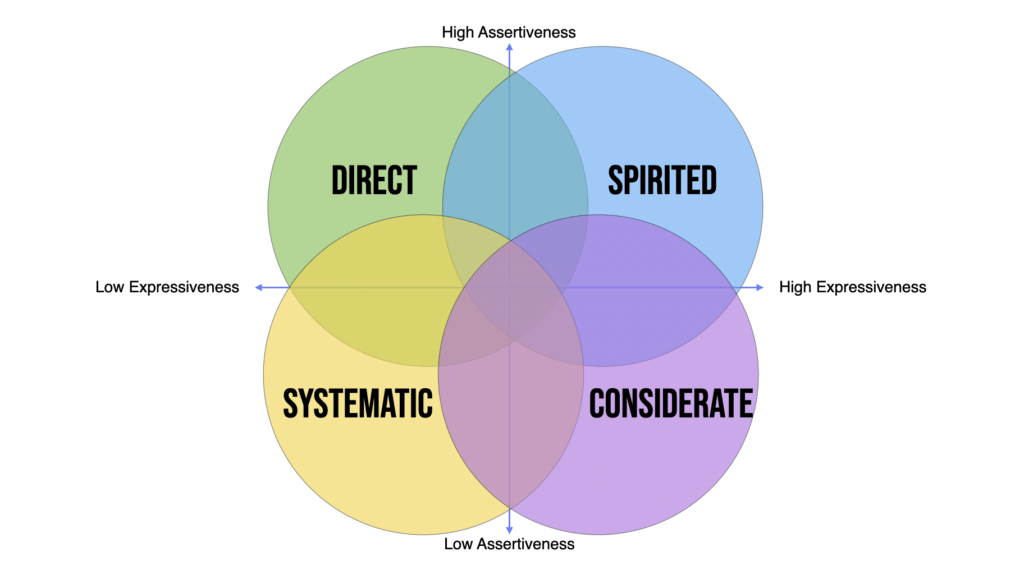
There are no right or wrong communication styles for great leaders — there are plenty of examples of Systematic or Considerate communicators who have done quite well for themselves. That said, many leaders fall somewhere between the Direct and Spirited end of the spectrum.
Putting it All Into Action
By reading this, you’ve learned a great deal about leadership. We discussed the Four Pillars of Leadership which is the 2×2 matrix I developed to provide people with a blueprint on how to become a better leader.
We also learned about 5 different styles of leadership and the people who fall into each one of those styles.
And we wrapped up by discussing the Communication Styles Matrix developed by Dr. Eileen Russo.
But just learning about these concepts doesn’t do you much good unless you put them into action. So be sure to take what you’ve learned and apply it to your daily life. By doing so, you’ll end up being the leader you’ve always wanted to be.
About Jamie Turner:
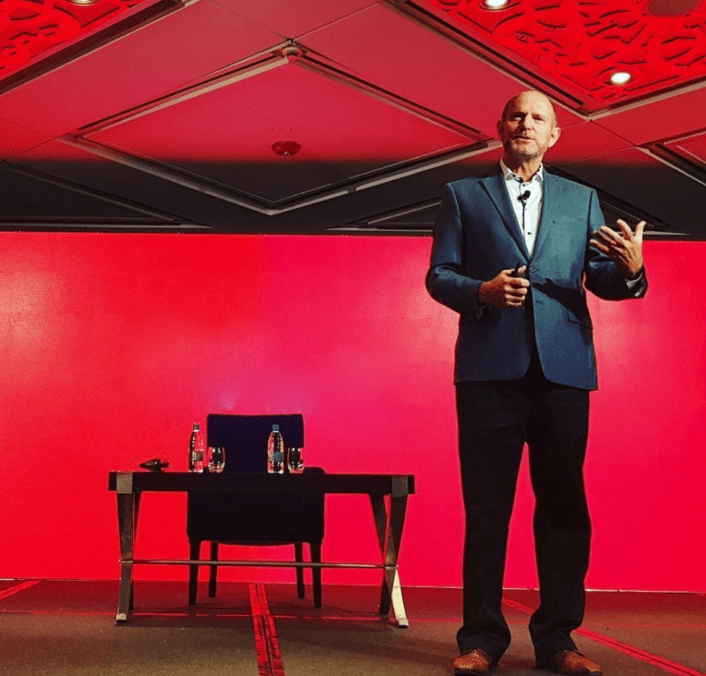
Jamie Turner is an internationally recognized author, professor, and management consultant who was recognized as a top 10 speaker by CarreerAddict (along with Ariana Huffington, Daymond John, and Gary Vaynerchuk). His client list includes The Coca-Cola Company, AT&T, Microsoft, Verizon, SAP, T-Mobile, and Holiday Inn. You may have seen Jamie in Forbes, Inc., Entrepreneur, Business Insider or the Wall Street Journal. He’s also a regular guest on CNN and HLN where he contributes segments on marketing, persuasion, and leadership. He teaches at Emory University and the University of Texas and has been profiled in one of the world’s best-selling textbooks. Jamie is the co-author of several essential business books including How to Make Money with Social Media; Go Mobile; and Digital Marketing Growth Hacks. He is the founder of 60SecondMarketer.com and has a new YouTube series called IN:60 which is available on YouTube and was designated as one of 8 “Top Business YouTube Channels” in the nation by Wishpond.com. He is also the co-founder of A School Bell Rings, a non-profit that improves access to education for impoverished children around the globe. If you’d like to find out more about having Jamie speak at your next event, click through to JamieTurner.Live.
